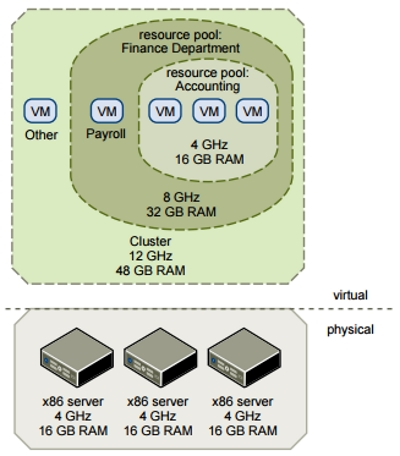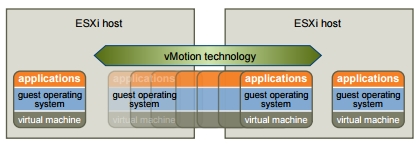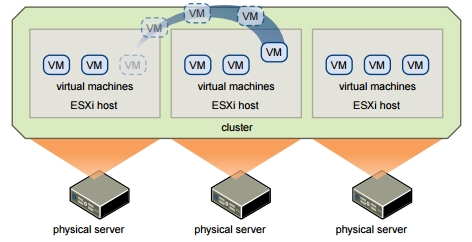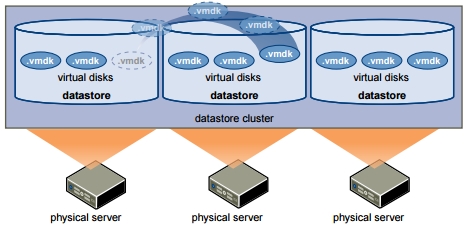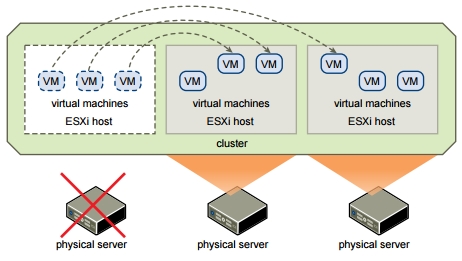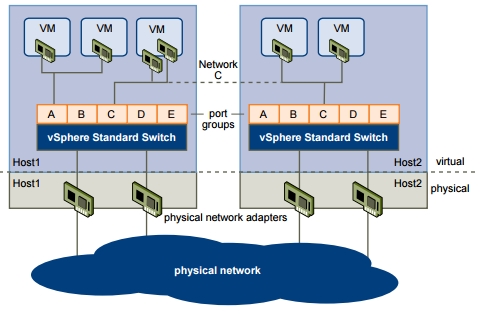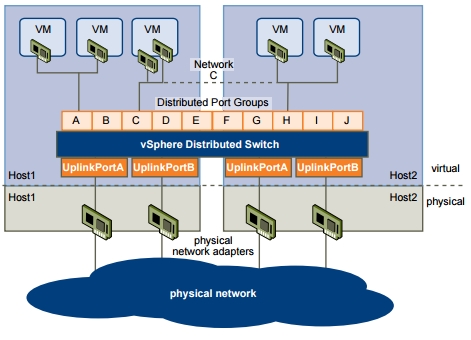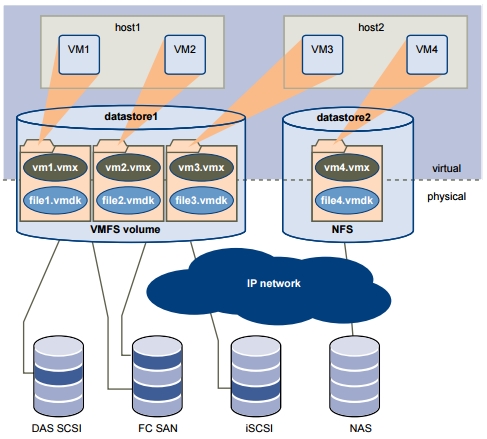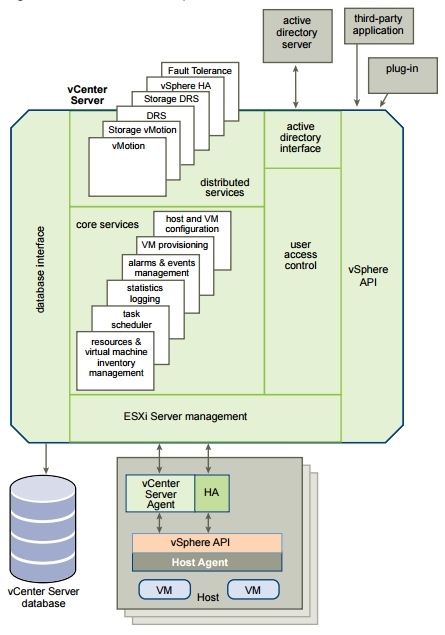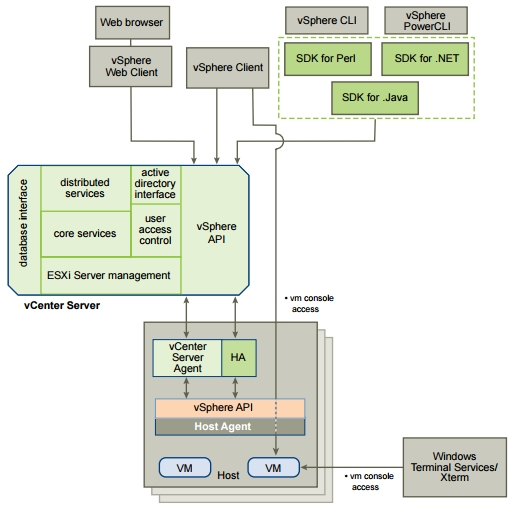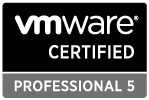
Virtualization Layer: vSphere Datacenter
Management Layer: VMware vCenter Server
Interface Layer: Accessing the Virtual Infrastructure
vSphere Datacenter
Virtualization layer consists of the ESi hypervisor, which abstracts processor, memory, video, storage and resources into virtual machines.
Virtual machines can be assigned to a particular host, cluster or resource pool, and a datastore and datastore cluster. Virtual machines consume resources dynamically as the workload increases or give back resources dynamically as the workload decreases.
Provisioning of virtual machines is much faster and easier than physical machines. New virtual machines can be created in seconds.
Hosts, Clusters, and Resource Pools
Hosts, clusters, and resource pools provide flexible and dynamic ways to organize the aggregated computing and memory resources in the virtual environment and link them back to the underlying physical resources.
A cluster acts and can be managed as a single entity. It represents the aggregate computing and memory resources of a group of physical x86 servers sharing the same network and storage arrays.
Resource pools are partitions of computing and memory resources from a single host or a cluster. Resource pools can be hierarchical and nested. You can partition any resource pool into smaller resource pools to divide and assign resources to different groups or for different purposes.
VMware vSphere Distributed Services
vSphere vMotion, vSphere Storage vMotion, vSphere DRS, vSphere Storage DRS, Storage I/O Control, vSphere HA, and Fault Tolerance are distributed services that enable efficient and automated resource management and high availability for virtual machines.
vSphere vMotion
With vMotion, you can migrate running virtual machines from one physical server to another without service interruption.
vSphere Storage vMotion
With Storage vMotion, you can migrate virtual machines from one datastore to another datastore without service interruption.
vSphere Distributed Resource Scheduler
vSphere Distributed Resource Scheduler (DRS) helps you manage a cluster of physical hosts as a single compute resource. DRS places virtual machines so that the load across the cluster is balanced, and cluster-wide resource allocation policies (for example, reservations, priorities, and limits) are enforced.
vSphere Storage DRS
Storage DRS helps you manage multiple datastores as a single compute resource, called a datastore cluster. A datastore cluster is an aggregation of multiple datastores into a single logical, load-balanced pool. You can treat the datastore cluster as a single flexible storage resource for resource management purposes. The load balancer manages initial placement and future migrations based on workload measurements. Storage space balancing and I/O balancing minimize the risk of running out of space and the risk of I/O bottlenecks slowing the performance of virtual machines.
vSphere High Availability
With vSphere HA, virtual machines automatically restart on a different physical server in a cluster if a host fails.
vSphere Fault Tolerance
vSphere Fault Tolerance on the ESXi host platform provides continuous availability by protecting the primary virtual machine virtual machine with a secondary virtual machine that runs simultaneously on a separate host.
Network Architecture
The virtual environment provides networking elements similar to those in the physical environment. They are virtual network interface cards (virtual NICs), vSphere Distributed Switches (VDS), distributed port groups, vSphere Standard Switches (VSS), and port groups.
vSphere Standard Switches
With vSphere Standard Switches, each server has its own virtual switch: VSSs handle network traffic at the host level in a vSphere environment.
vSphere Distributed Switches
A vSphere Distributed Switch (VDS) functions as a single virtual switch across all associated hosts. This ability allows virtual machines to maintain consistent network configuration as they migrate across multiple hosts.
VMware vShield and Network Security
VMware vShield is not a component of vSphere, but as a companion to vSphere it provides security for applications and data in the cloud.
- vShield Zones provides firewall protection for traffic between virtual machines.
- vShield Edge provides network edge security and gateway services to isolate the virtual machines in a port group, distributed port group, or Cisco Nexus 1000V.
- vShield App is an interior, virtual-NIC-level firewall that allows you to create access control policies regardless of network topology.
- vShield Endpoint delivers an introspection-based antivirus solution. vShield Endpoint uses the hypervisor to scan guest virtual machines from the outside without an agent.
Storage Architecture
VMFS
VMFS is a clustered file system that leverages shared storage to allow multiple physical hosts to read and write to the same storage simultaneously. VMFS provides on-disk locking to ensure that the same virtual machine is not powered on by multiple servers at the same time.
VMFS also features failure consistency and recovery mechanisms, such as distributed journaling, a failureconsistent virtual machine I/O path, and virtual machine state snapshots.
VMFS also supports raw device mapping (RDM). RDM provides a mechanism for a virtual machine to have direct access to a LUN on the physical storage subsystem (Fibre Channel or iSCSI only). RDM supports two typical types of applications
- SAN snapshot or other layered applications that run in the virtual machines
- Microsoft Clustering Services (MSCS) spanning physical hosts and using virtual-to-virtual clusters as well as physical-to-virtual clusters.
VMware vCenter Server
VMware vCenter Server provides centralized management for datacenters. vCenter Server components are user access control, core services, distributed services, plug-ins, and various interfaces.
The User Access Control component allows the system administrator to create and manage different levels of access to vCenter Server for different classes of users.
vCenter Server Core Services
Core Services are basic management services for a virtual datacenter.
- Virtual machine provisioning
- Host and VM configuration
- Resources and virtual machine inventory management
- Statistics and logging
- Alarms and event management
- Task scheduler
- vApp
Multiple vCenter Server systems can be combined into a single connected group.
vCenter Server Plug-Ins
vCenter Server plug-ins extend the capabilities of vCenter Server by providing more features and functions.
- Base Plugins
- vCenter Storage Monitoring
- vCenter Hardware Status
- vCenter Service Status
- Require separate installation and Updates
- vSphere Update Manager
- vShield Zones
- vCenter Orchestrator
- Data Recovery
vCenter Server Interfaces
vCenter Server interfaces integrate vCenter Server with third party products and applications
- ESXi server management
- VMware vSphere API
- Active Directory interface
- Database interface
Accessing the Virtual Infrastructure
Users can access a VMware vSphere datacenter through the vSphere Client, through a Web browser with vSphere Web Client, through a command line interface, or terminal services.
vSphere Client and vSphere Web Client
All administrative functions are available through the vSphere Client. A subset of those functions is available through the vSphere Web Client.
Using the vSphere Client
The vSphere Client is a downloadable interface for administering vCenter Server and ESXi.
- When the server is a vCenter Server system, the vSphere Client displays all the options available to the vSphere environment, according to the licensing configuration and the user permissions.
- When the server is an ESXi host, the vSphere Client displays only the options appropriate to single host management.
Using the vSphere Web Client
The vSphere Web Client is a browser-based interface for configuring and administering virtual machines.
SDKs and Command-Line Interfaces
vSphere includes CLI commands for provisioning, managing, and monitoring hosts and virtual machines. vSphere SDKs provide standard interfaces for VMware and third-party solutions to access vSphere.
- vSphere PowerCLI
- vSphere SDK for Perl
- vSphere CLI (vCLI)
- vSphere SDK for .NET
- vSphere Web Services SDK
Direct Virtual Machine Console Access
If the virtual machine is running and the user knows the IP address of the virtual machine, the user can directly access the virtual machine console by using standard tools, such as Windows Terminal Services.
Resources
